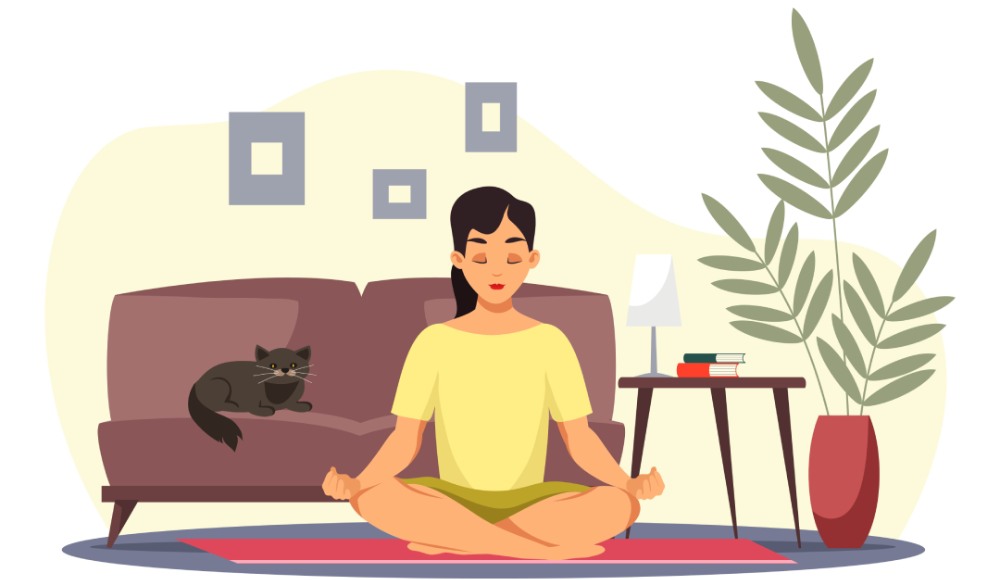“Self Soothing” refers to technique or a behaviour used by an individual in order to regulate their emotional state by themselves. It is used to regain equilibrium especially after an upsetting event. It involves utilizing various techniques or strategies to provide comfort, relaxation and relief from negative thoughts or overwhelming situations.
The concept of self soothing originates from various psychological theories and therapeutic approaches. There is no particular individual credited with inventing this practice per say but this technique is deeply rooted in CBT, Mindfulness – based practices and attachment theory.
Self soothing is crucial for restoring balance to our bodies after a stressful or traumatic event so as to return the equilibrium. Social support plays a crucial role in restoring the equilibrium but at times it may not be available. Such situations give rise to practicing the wrong self soothing techniques. Common practices for the same could mean that indulging in foods or other means that would provide temporary relief but that can do more harm in the future.
For example, self soothing behaviours are largely seen in diagnoses like Autism spectrum , Anxiety disorders, Depression or Trauma. Skin picking, self harm, indulgence in alcohol or other substances, are the examples of self soothing behaviours individuals use in response to their own situations. They might not be appropriate- socially or physically/ emotionally but they provide temporary relief from present circumstances which does more harm than help. It is thus crucial to differentiate appropriate and inappropriate behaviours, identify them and make the right choices.
Also check : Clinical Psychologist in India
Self Soothing Techniques
Given the complex circumstances it might seem tough to make constructive choices and indulge in the beneficial behaviours. But with practice it can be possible to inculcate these appropriate behaviours thus providing right kind of relief in such situations.
There are ways in which the theories or concepts mentioned above promote appropriate self soothing practices. They are as follows :-
- CBT : Cognitive Behavioural Therapy emphasizes the importance of learning coping skills to manage emotions and stress which often includes techniques for self-soothing such as relaxation exercises and cognitive reframing.
- Mindfulness based practices : They teach individuals to cultivate awareness of thoughts and emotions and to respond to them with compassion and acceptance thus promoting self soothing.
- Attachment theory : Proposed by John Bowlby and further developed by Mary Ainsworth, highlights the significance of early caregiver interactions in shaping an individual’s ability to self-soothe. Secure attachment in infancy lays the foundation for developing effective self-soothing strategies later in life.

The need of self soothing techniques especially stem from the effect of Psychological disorders like PTSD, anxiety, depression, and emotional irregularities that come with them. They profoundly influence behavior and mental well-being. Individuals with PTSD may exhibit avoidance behaviors and hypervigilance, while anxiety disorders can lead to persistent worry and avoidance of triggering situations. Depression often manifests as withdrawal from social interactions and feelings of worthlessness. Emotional irregularities, such as mood swings, can result in impulsive actions and strained relationships.
These disorders not only affect behavior but also disrupt emotional regulation, cognitive functioning, and interpersonal relationships, highlighting the complex interplay between mind and behavior in the context of psychological health.
Following are a few behaviours one can indulge in. These are safe self soothing behaviours that may benefit an individual to regulate themselves emotionally and find a balance in overwhelming and traumatic situations.
1. Deep Breathing: Taking slow, deep breaths to activate the body’s relaxation response and reduce stress.
2. Mindfulness Meditation: Engaging in mindfulness practices to cultivate present-moment awareness and acceptance of thoughts and emotions.
3. Progressive Muscle Relaxation: Systematically tensing and relaxing muscle groups to release physical tension and promote relaxation.
4. Sensory Activities: Engaging the senses through activities such as listening to calming music, lighting scented candles, or taking a warm bath.
5. Grounding Techniques: Using sensory cues to anchor oneself in the present moment, such as focusing on the sensation of touch or naming objects in the environment.
6. Positive Visualization: Imagining soothing or comforting scenes to evoke feelings of relaxation and safety. It reduces the worry caused by a situation by distracting an individual for a second but in a right way and for the right time. Thus when they stop the visualisation they are more calm and ready to make better and rational decisions than before.
7. Journaling: Writing down thoughts and feelings to process emotions and gain perspective on stressful situations. Penning down the thoughts give them a direction thus helping in taking rational, well thought decisions. Journalling for self also makes it feel like being heard which can go a long way in terms of self esteem and growth.
8. Physical Exercise: Engaging in physical activity to release endorphins and alleviate tension and anxiety. They not only distract the mind and bring focus on the body but it also helps the mind to be in the present thus reducing the anxious or worries about the past or the future.
9. Creative Expression: Participating in creative outlets such as painting, writing, or crafting to express emotions and promote self-expression. Dance Movement therapy, Art therapy may be helpful in providing such outlets.
10. Self-Compassion: Offering oneself kindness and understanding during difficult times, practicing self-care, and nurturing oneself with comforting activities or rituals.
Apart from these behaviours, there are few other techniques that are used.
1. Cortisol Self Massage :– A short massage of neck, shoulder and hands in order to let go of the worry could help individuals with stressful situations
2. Tapping :- Tapping is a self-soothing method used by the emotional freedom technique (EFT), which involves lightly tapping on acupressure points on different parts of the body. It helpes regulate the stress and breath levels.
3. Butterfly Hug :- The butterfly hug technique combines tapping with focused breathing and positive affirmations, such as, “I’m safe and secure” or “I am loved,” and is an excellent grounding technique that can be used anywhere.
In conclusion, self-soothing behaviors offer invaluable tools for navigating life’s challenges and promoting emotional well-being. By incorporating techniques such as deep breathing, mindfulness meditation, and sensory activities into the daily routines, one can cultivate resilience and inner peace.
These practices not only help to manage stress and anxiety but also enhance the ability to regulate emotions, make sound decisions, and maintain healthy relationships.
Cultivating these habits might seem tough or impossible at first but their effectiveness and impact prove them to be worth cultivating and nurturing. Individuals not only feel better in the situation but more importantly feel in control of the situation which in turn increases their strength and confidence from within.

